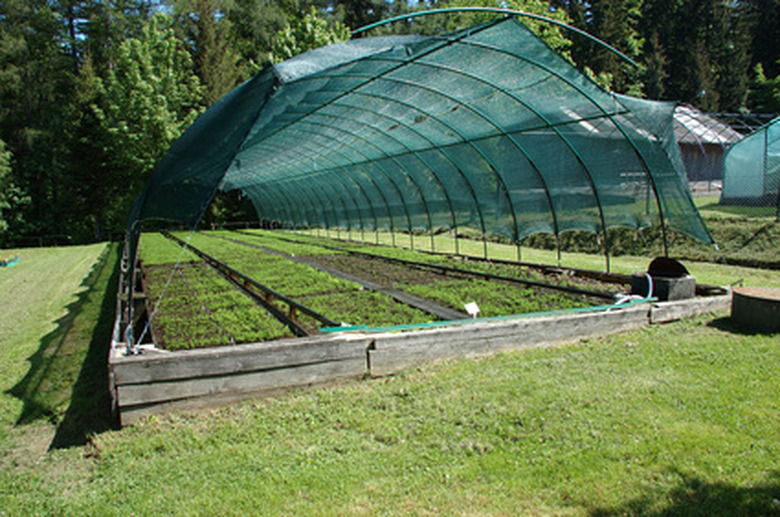How To Grow Vegetables In A Hothouse
Things Needed
- Potting soil
- Turkey baking bag
- Cake pan
- Oven
- Cooking thermometer
- Bleach
- Pottery shard
- Container
- Trowel
- Watering can
- Pruning shears
- Greenhouse thermometer
"Hothouse" is another word for greenhouse. Whether your greenhouse is a temporary shelter made of plastic, or a permanent location made of glass and wood, a greenhouse is a good way to extend the growing period of plants at both ends, and to grow cool-weather crops such as cabbage or radishes year-round. Greenhouses are simple to operate, although daily monitoring is required to keep the temperatures optimal and avoid diseases.
Step 1
Plant vegetables in sterile soil in your greenhouse. Most newly purchased soil was sterilized before sale. But as you grow plants in your greenhouse, they may develop diseases. Before recycling soil, place it in a basting bag and put in a cake pan. Place a cooking thermometer into the center of the bag. Place it in an oven set at 250 degrees until the internal temperature of the soil reads 180 degrees. Mix a balanced, granulated fertilizer (10-10-10) into the soil to add nutrients back to it before planting.
- "Hothouse" is another word for greenhouse.
- Whether your greenhouse is a temporary shelter made of plastic, or a permanent location made of glass and wood, a greenhouse is a good way to extend the growing period of plants at both ends, and to grow cool-weather crops such as cabbage or radishes year-round.
Step 2
Clean all containers before planting. Containers may be cleaned with a solution of one part bleach and nine parts water. Wash all plastic containers and rinse thoroughly to remove all traces of bleach. Place a pottery shard at the bottom of a sterile container before planting. Fill the container with a sterile soil mix and hollow out a planting pocket for the seed or plant. Seeds should be planted in drill holes twice as deep as the seed's thickness at the widest point. Plants should be planted in pockets at the soil line of the root ball. Cover the seed or root ball with soil and water.
- Clean all containers before planting.
- Fill the container with a sterile soil mix and hollow out a planting pocket for the seed or plant.
Step 3
Place the containers of plants or seeds far enough apart in the greenhouse to promote good circulation. Tie up plants such as tomatoes and beans so that they do not sprawl and decrease circulation. Poor circulation between plants is a contributing factor to mildew, mold and diseases such as blight.
Step 4
Check the greenhouse temperature up to four times daily. Vent the greenhouse whenever it gets too warm by opening a door. Vegetables have different optimal temperatures to produce well. Lettuce thrives at daytime temperatures up to 65 degrees and nighttime temperatures down to 45 degrees, but will wilt at higher temperatures. By contrast, tomatoes prefer daily temperatures up to 90 degrees and nighttime temperatures no lower than 65 degrees.
- Place the containers of plants or seeds far enough apart in the greenhouse to promote good circulation.
Step 5
Walk through your greenhouse daily and check each plant. Water plants that have dry soil. Most hothouse vegetables require soil as damp as a wrung-out sponge. Look over each plant as you water it for signs of disease such as wilt that causes branches to collapse or powdery mildew that leaves a baby powder-like residue on leaves and stems. Remove diseased plants from your greenhouse to treat in order to avoid the spread of disease. Also observe plants for pests such as aphids or white flies. Wash plants with insect infestation with an insecticidal soap.
- Walk through your greenhouse daily and check each plant.
- Look over each plant as you water it for signs of disease such as wilt that causes branches to collapse or powdery mildew that leaves a baby powder-like residue on leaves and stems.
Step 6
Harvest vegetables once they ripen. Do not allow greenhouse vegetables to become overripe. Rotting vegetables release ethylene gas into the air, which can speed ripening and hasten rotting among other vegetables.
